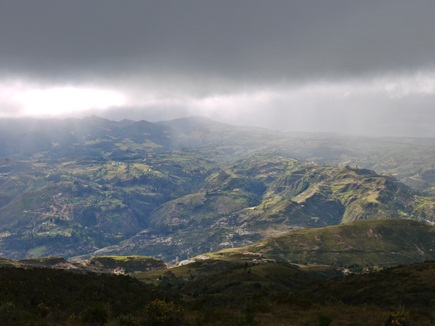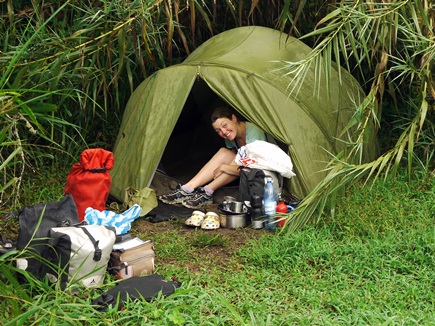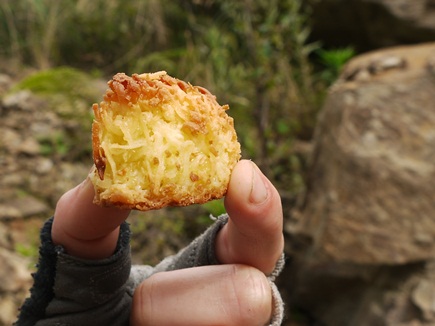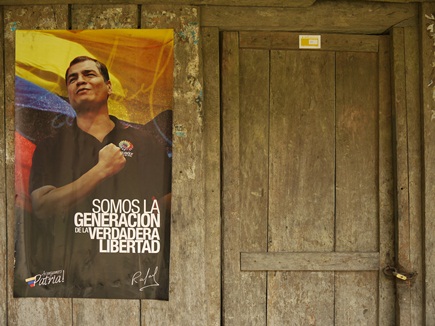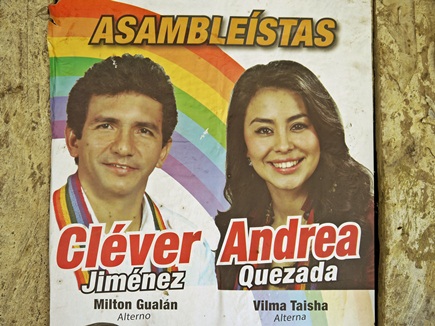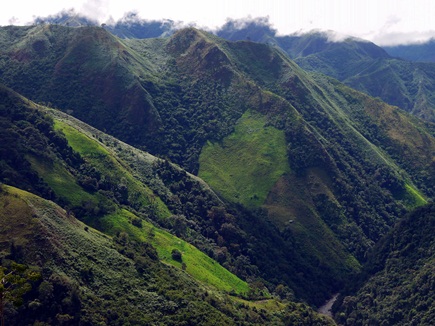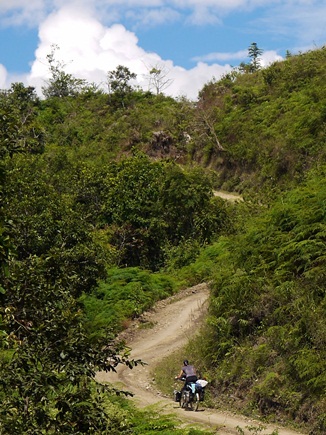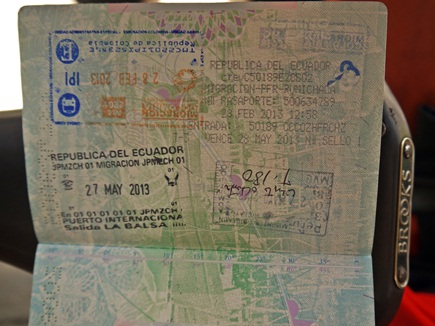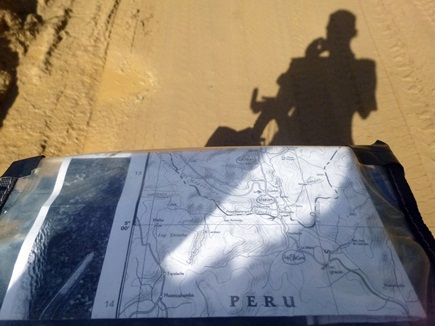Recipe: Rhiannon flatbread
May 16th, 2013

Rhiannon flatbread: flour, oil, salt, water and a hot pan
Flatbread was one of the food highlights for us during our month at Rhiannon. On the road we crave quick and easy fresh bread. Flatbread is the perfect camping solution, but a couple of less than successful attempts had put us off.
Enter Helen’s recipe, which makes great bread with ingredients that you can find in even the dustiest of roadside tiendas. No need for baking powder or to wait and let the dough prove. The secrets seem to be the hot water, which keeps it light, and the oil, which means you can dry fry.
Ingredients
To make 10 flatbreads
– 3 cups of flour (white or wholemeal, a mix works well)
– A few pinches of salt
– Couple of drops of oil
– 1 cup of hot water (not quite boiling)
Optional: any dried herbs/spices you have available – oregano, rosemary or cumin work well, or add cinnamon and panela to make a sweet version.
Method
– Mix the flour, salt and oil together in a bowl.
– Slowly add the hot water and knead to an elastic dough.
– If the mixture is still wet, add flour until it stops sticking to your hands.
– Roll the dough out into one big shape, about 1/2cm thickness. If you’re camping, lay out some plastic bags on a flat surface.
– Spread the dough on one side with a thin layer of oil.
– Roll the dough up into a long sausage shape.
– Slice the sausage up into 10 (or however many breads you want to make)
– Roll out each bread individually into the thickness you want – about ½cm for chewy, naan style bread; or thinner for tortilla style.
– Dry fry in a hot pan until it browns.
South African stickbread
If you have a campfire, then stickbread is a delicious and easy variation on the flatbread recipe. It comes courtesy of the Rhiannon South African contingent, Jaco and Stefan, who cooked an amazing meal for us one night of stickbread and veggie kebabs.
You can also try the recipe with beer instead of water – easy bread with just beer and flour!
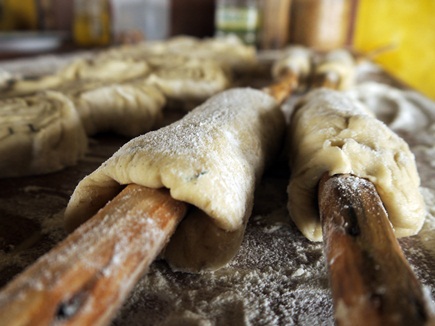
South African stickbread: just add campfire
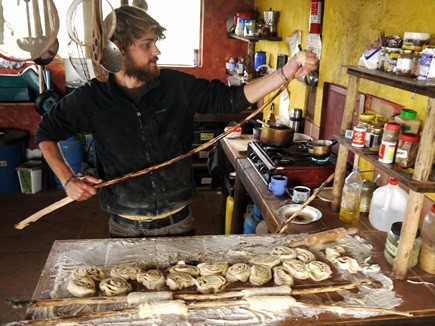
Use exactly the same recipe and method as above, but once you have rolled up and sliced the bread “sausage”, simply skewer each bread onto a fresh, green stick…
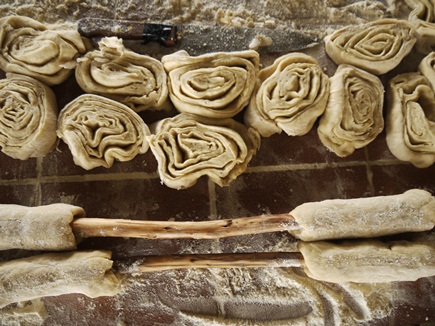
…you should end up with something that looks like a bread barbell.
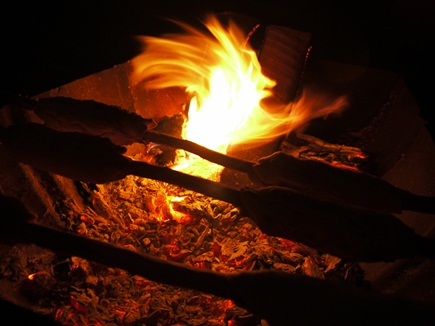
Hold the stick over the embers and rotate. Once it’s cooked, the bread will slide off, and break into crispy, pastry-like layers. Buen provecho!
Rhiannon: grub’s up!
May 17th, 2013
“Eat Food. Not too much. Mostly plants.”
Michael Pollan, In Defense of Food
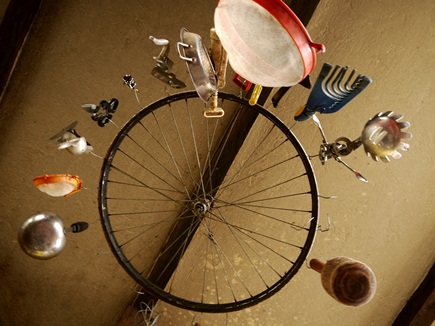
Every good meal begins with a bike: select your kitchen implements from Rhiannon's bike wheel of culinary fortune…and start improvising.
I have to admit it, I was nervous. A month on an organic farm in the middle of nowhere, eating a largely vegan diet cooked by other people? For a touring cyclist who has spent most of his waking hours over the past two years plotting his next food hit, surely this was, well, food suicide?
The vegan bit didn’t bother me – our diet on the road is almost entirely vegetarian, and I figured I could cope for a few weeks without eggs and cheese – but the other people bit did. Imagine handing over control of my daily calorie intake to a group of people I’d never even met, most of whom weren’t even cyclists? Forget riding centimetres from enormous 18-wheel trucks, or wild camping at the mercy of imaginary thieves or murderers, this felt by far one of the riskiest things we had done all trip.
Get a grip, I told myself – surely it can’t be that bad. Challenge yourself. Get out of your food comfort zone. And so, with a pannier stocked with bread, jam and bananas – the hungry cyclist’s international safety blanket – I set off in trepidation. As we rode through the last few villages before the farm, I made a mental note of the nearest bakeries – distance, road surface, elevation – and calculated how long it would take to ride there in a crisis situation. Better to be prepared, I thought.
I really had nothing to worry about. Over the past month at Rhinannon, I have eaten some of the most delicious, healthy and inventive food I have ever eaten. If I feared a food crisis before I arrived, then I left with a food education.

Breakfast is the simplest and quickest of the three meals, but still delicious: porridge with panela (brown sugar), fruit salad with pineapple, orange and banana, and hot, deep fried empanadas.
Cooking at Rhiannon is a communal affair, with a group of typically three volunteers responsible for cooking each of the three meals a day for between 20 and 25 people. There are no rules, no set menus, no real recipes to speak of – improvisation is the key, and as long as it tastes good, and there’s plenty of it, no-one will be complaining. We were lucky enough to be there at the same time as a group of volunteers who shared our passion for food, and at times it resembled some kind of International Masterchef as people competed to out-do previous meals. For a couple of food junkies like us, it was the very best kind of competition to be involved in.
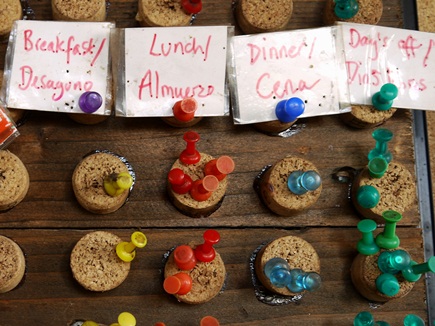
The Rhiannon cooking rota board: culinary battle lines are drawn.
Iin the spirit of Ready Steady Cook, every meal is concocted from whatever is available on the day. The larder is always stocked with a vast array of grains and pulses: rice, lentils, oats, various beans, chickpeas and quinoa.

Daily salad harvest from the Rhiannon garden.
To this is added a daily harvest of salad leaves and vegetables from the garden, plus a weekly delivery of fruit and vegetables to top up Rhiannon’s own fledgling production. For flavour, there is a good range of herbs and spices, plus plenty of flour and panela for pancakes, bread and pastry.
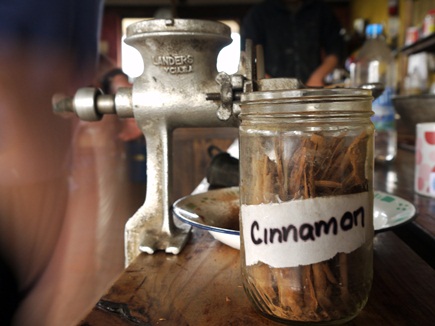
Cinnamon: grind fresh and add liberally to porridge, pancakes, cakes and biscuits.
I had thought that cooking vegan food would be tough – but it really wasn’t. Firstly because there were no non-vegan ingredients in the kitchen, there was no temptation. If it came out of the kitchen, it would – by definition – be vegan. And secondly because there really are so many good alternatives to dairy. Making really good pie pastry without butter, and delicious pancakes without milk or eggs made me realise that often the dairy element is added just out of habit – and not always because it is really necessary. For cycle touring, where we very rarely have access to a fridge, learning some vegan recipes and alternatives to dairy ingredients really was invaluable.
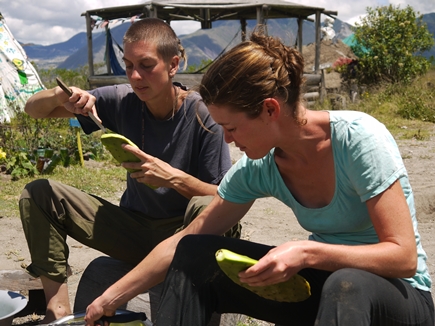
Nothing is overlooked as a food source – after being heated on the burner to loosen the spines, locally foraged nopal cactus is prepared for the pot by Helen and Sarah.
So what exactly did we eat during the last month? In no particular order, here are our top ten favourite Rhiannon dishes – all of them 100% vegan:
- Flora’s carrot cake with lemon icing – a rare cake success in the fire
- Roasted rosemary and garlic potato wedges, served with spicy tomato ketchup and lentil salad – myself and Sarah
- Crepe basket with pineapple and banana, courtesy of Guillaume and Sara, the often imitated but never outdone French duo
- Root vegetable pie with sweet onion gravy – a British team effort
- Matt’s banana pancakes with panela and cinnamon syrup
- Sarah’s chocolate and avocado mousse, served with panela flatbread and uvillas (a sour-sweet berry) from the garden
- Jaco and Stefan’s South African firepit feast: marinated vegetable kebabs, stickbread, salty bean salsa and salad
- Lentil bangers with mustard mash and greens – another British creation aimed squarely at the comfort food sweet spot
- Spicy peanut butter sauce from Sauce Queen Laura
- And last but definitely not least, Rhiannon flatbread – so good we’ve decided it deserves a blog post of its own to share the recipe.
Having both recently read Michael Pollan’s excellent food books The Omnivore’s Dilemma and In Defense of Food , our food experience over the past month has simply served to underline his eminently sensible eater’s manifesto: “Eat Food. Not too much. Mostly plants.”
At Rhiannon, it’s simple to follow his rules. There are none of Pollan’s dubious, “edible food-like substances” – those you find lurking in the middle aisles of your supermarket, with an ingredients list as long as your arm. There are just simple, fresh and tasty ingredients – and when you combine those with just a dash of invention, it becomes easy to keep even the hungriest cyclist happy.
James
Rhiannon: a day in the life
May 18th, 2013
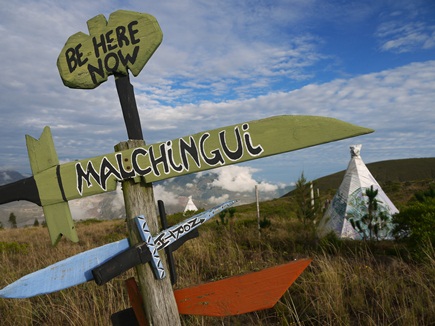
Be here now: welcome to the wonderful world of Rhiannon.
It’s interesting to watch how your concept of a bike tour evolves as you travel. A trip that began as a fairly focused, 18 month bike ride from Alaska to Patagonia has evolved into what we hope by the end will have become a meandering three year adventure – in which what we do off the bike has become almost as important and stimulating as what we do on it.
We quickly discovered that going slowly was our preferred way to travel by bike – riding slow with our eyes open, rather than fast with our heads down. By avoiding the direct routes wherever we can, and opting for the zig-zagging, minor roads, we have given ourselves more opportunities to discover the details of the places we travel through – and most importantly to meet just some of the the people who live there.
Yet doubling the time frame for our trip has not only given us the luxury of going slowly when we are on the bike, but has also opened up the possibilities of actually stopping. Of extracting ourselves from the often introspective, destination-oriented world of bike touring, and opening our eyes to other things that interest us. The past month we have spent at the Rhiannon Community in Ecuador is testament to the fact that – for us at least – this stop-start approach seems to be the perfect bike touring combination.
It would be impossible to do a long bike trip without gaining an increased sense of awe at the power and beauty of the natural world, and at the same time a creeping sense of despair at the rate at which man is destroying it. Moving slowly on a bike through rural areas, camping and living a relatively low-impact, minimal existence makes you think long and hard about our connection with the land, and the natural resources we take for granted. For a long time we had been keen to learn more about sustainability in practice, and working as a volunteer on an organic farm seemed like the perfect low-cost way to do it.
We chose Rhiannon because as novices it seemed to offer a good taster of the broad range of things we were interested in: not just organic farming, but also sustainable construction, community living, yoga, meditation and good vegetarian food – all with a sprinkling of Ecuadorian new age hippy thrown in for good measure. It’s run by Helen and Nicky, an English couple who fell in love with the view from a farmhouse perched on a ridge north of Quito – and decided it would be be the perfect place to start their own sustainable community. Over the past five years, they have transformed what was a piece of over-farmed, arid semi-desert into a thriving community with a family of between 10 and 20 ever-changing volunteers at its heart.
Our experience at Rhiannon turned out to be everything we had hoped for: challenging, rewarding, frustrating and hilarious, often all the the same time. We spent an inordinate amount of time up to our elbows in donkey poo. We learned how to massage each other’s legs after a hard day on the bike. Sarah pulled off a headstand in yoga and I almost touched my toes. We discovered that you can make a pretty good chocolate mousse just with an avocado and a bar of chocolate. We helped design and build a swinging bed, then slept on it and felt seasick. We discovered that for South Africans “flapjacks” are actually pancakes. We watched how waste – from our own pee to glass wine bottles – can nearly always be turned into something useful. In an exaggerated display of Englishness, we said “lovely” and “super” far more than is really necessary. We ate our beloved Marmite for the first time in nearly two years. We almost fainted in a temascal “sweat lodge” ceremony. Oh, and we got parasites. Again.
If hippy means living as sustainably as possible, connected to the land and in a supportive, family community, then I for one came away a convert.
James
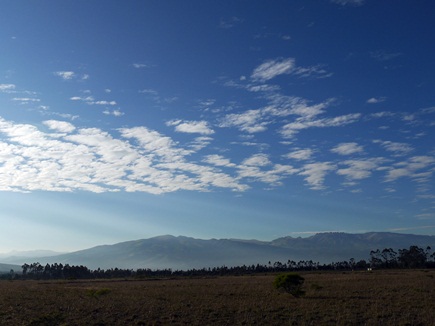
6am. Up early to take in the early morning views. Perched high on a ridge near the village of Malchingui, Rhiannon has a stunning, ever-changing 360 degree panorama…
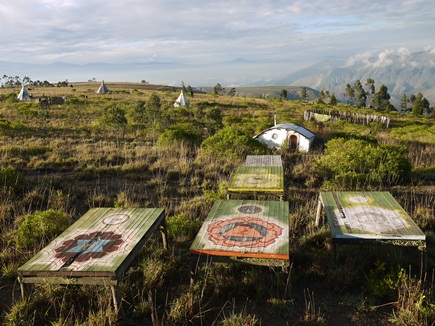
…where mountains and volcanoes loom beyond the tipis and yoga platforms. On a clear day you can see 17 volcanoes from here…
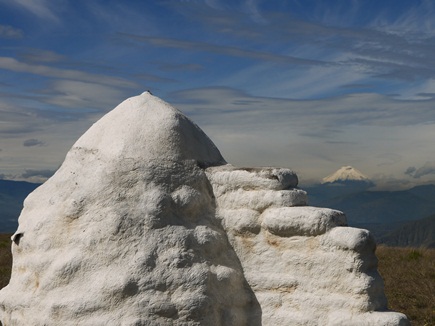
…and as always, my gaze is drawn back to the perfect cone of Cotopaxi – here mirrored by the roof of the Gnome Dome, one of Rhiannon's growing cluster of adobe houses.
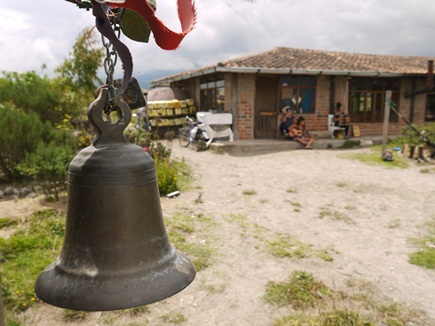
6.45am. Breakfast Bell. Life at Rhiannon revolves around two things: the bell, which means that food is ready…

…and the rota boards, which set out your day's work. As well as the five hours work a day, as a volunteer you are also responsible for cooking one of the three meals each day. The food at Rhiannon was so good, we decided it warrants its own separate blog post.

You're never far from music at Rhiannon. Here Joel – a bass guitarist from the US – and Elizabeth – a yoga teacher from Jamaica – squeeze in a morning session over their breakfast tea.
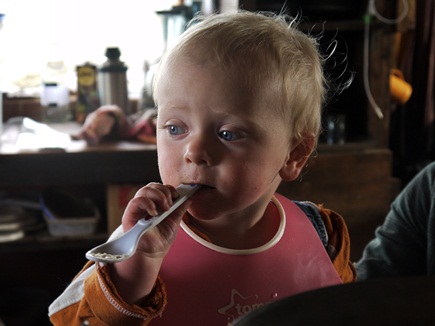
7am. Take on the breakfast challenge: trying to get food into the mouth of Helen and Nicky's daughter Satya faster than she is able to throw it onto the floor. On most days, it's a losing battle.
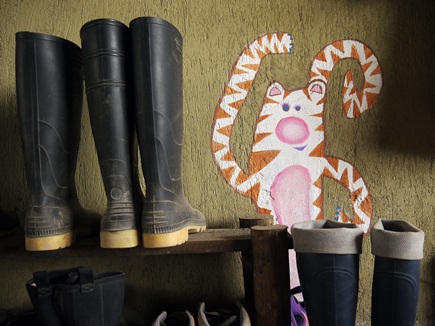
7.45am. Pull on the wellies for morning chores – including feeding the chickens and dogs, taking the donkeys out to graze, cleaning the house and watering the gardens.
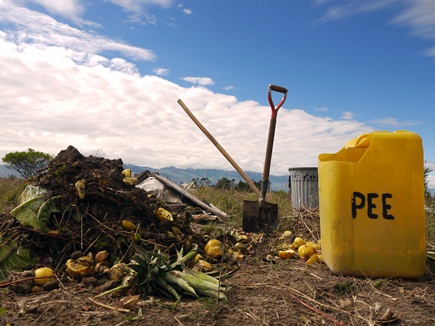
For me, early morning means compost making. Rhinannon's compost recipe is a perfect example of the farm's philosophy in action, where “waste” is turned into something useful. Take leftover organic material from the kitchen, throw in a few handfuls of donkey poo, combine with ash from the fire, and bind together with yesterday's pee collected from the toilets. Cover with plastic sheeting to marinate in the sun, turn daily and bingo – within two weeks you have rich, homemade compost.

8.30am. The day's work begins in earnest. I spend much of my time working on the farm's earthbag houses, which will provide accommodation for future volunteers. First, bags are tightly packed with earth dug from beside the house, before being carefully stacked to form the structure. The hole dug to build the house is then terraced and planted, creating a kitchen garden which will help to feed the community.
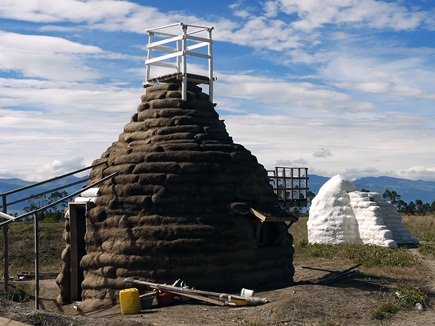
Once the structure of the house is complete, it's covered inside and out by hand with a layer of adobe: a traditional mix of sand, sawdust, water, and – the secret ingredient – donkey poo, which acts as the glue to bind the mix together. The donkeys, Ursula and Freya, are a critical link in the Rhiannon chain – as long as they are pooing, everyone's happy.
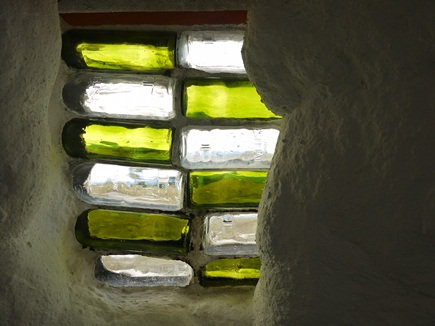
Once the adobe dries, it's then sealed with a coat of paint or cactus juice, making it weatherproof for a good few years. A window made using recycled glass bottles lets in light and provides a splash of colour.

The finishing touches – Nicky decorates the “Snake Pit” in one of the larger adobe houses, where we also helped to construct a swinging double bed from old pallet boards.

And here's one they built earlier, the Hobbit House: an earthbag and adobe home, built largely from local and recycled materials – and all for just a few thousand dollars. A touch more charm and character than your average lego-brick, Persimmon estate house, don't you think? I would happily live in a Hobbit House…
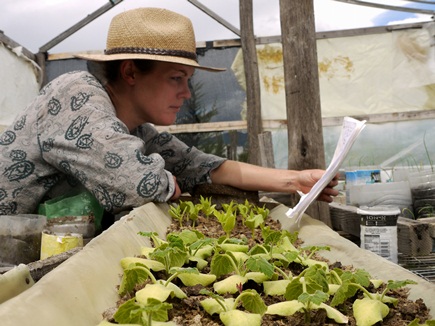
After three weeks of cleaning the donkey poo from under her fingernails, Sarah spends her last week in the greenhouse, cultivating locally collected seeds to grow avocado, beetroot, onion, beans and maize. In the semi-desert climate, everything needs careful nurturing and watering, but the long term aim is for the farm to become as self sufficient in food as possible.
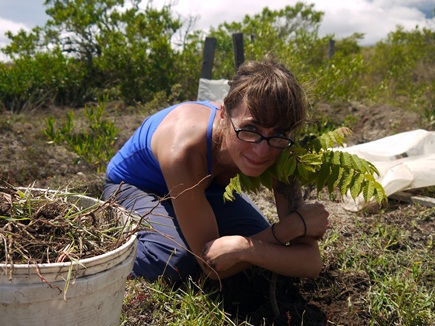
Trees are essential in this process, helping to retain water and provide shelter from the gusting wind. Regular weeding, mulching, a daily dose of pee from the toilets and a hug from Karrey helps them on their way.

1.30pm. With no connection to the grid, power on the farm comes from these solar panels. Hot water also comes from the sun, warmed all morning in a series of outside pipes – making this prime time for a deliciously hot shower before lunch. Used shower water is then directed through natural filters into a lagoon, from where it can be re-used to irrigate the gardens.
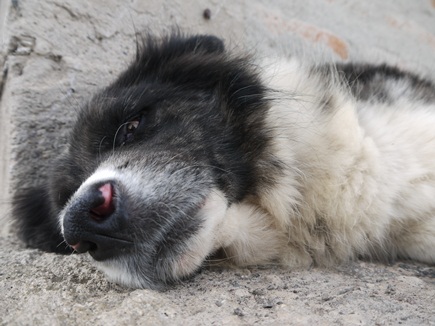
2.30pm. After lunch, work is done for the day and the Rhiannon playground is yours. If laziness strikes – like it often does for Azul, the most relaxed of the farm's seven dogs – then pick a book from the library…
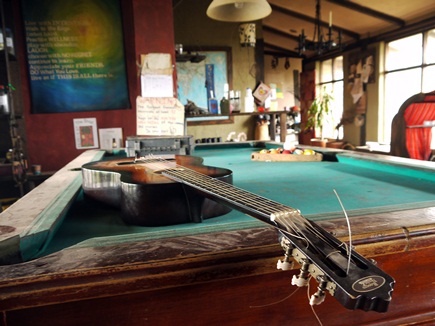
…head for the lounge and raid the stash of local Salinas chocolate in the community shop…
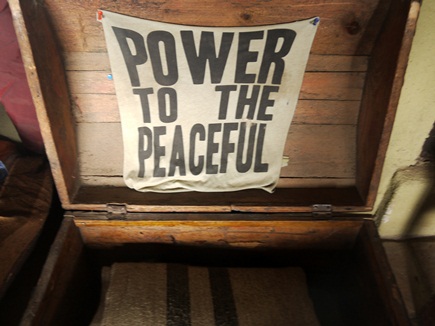
…grab a blanket from the box…
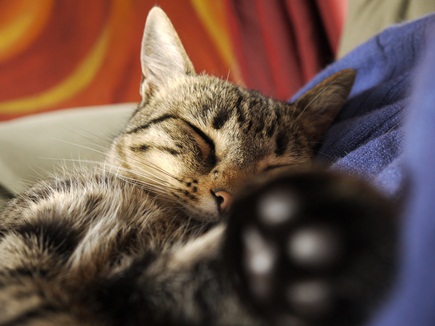
…and curl up. If you're lucky, you'll be rewarded with a visit from Chachi, a cute, ever-purring ball of fur with a magnetic attraction to a warm lap. One evening, she even managed to find her way into my sleeping bag, where she slept quite happily for the night.
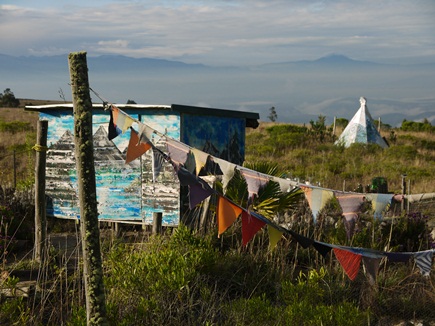
If you're feeling the need for some solitude and contemplation – and you're not claustrophobic – then the meditation hut might be just what you need to help empty your mind.
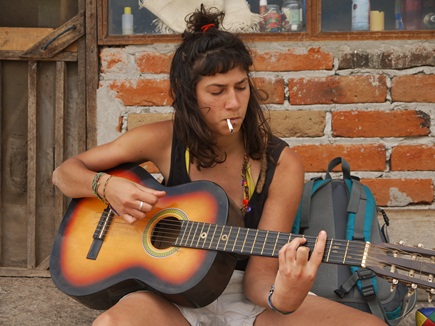
If you're after something more energetic, then there are plenty of options: sing along with Italian Federica…

…join in a hula hooping masterclass led by South Africans Stefan and Jaco…
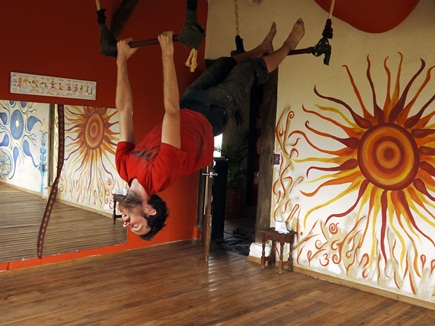
…or even practice some acrobatics in the Yoga Room. Speaking of which, yoga was one of the big draws for us to Rhiannon, and we had a great introduction courtesy of several different teachers…

…including Nicky, who is here demonstrating what is supposedly the yogi “sleeping position”. Not that I got anywhere near this – as a clasically inflexible and hamstrung cyclist, I'm still working on the basics – but we did come away with lots of good new stretches to counteract our cycling posture, and a desire to do much more yoga in the future.
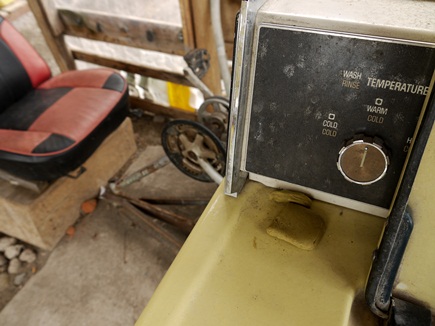
If the smell of your own clothes is becoming overpowering, then it's probably time for a spin in the pedal-powered bicilavadora…

…and if you still have energy left, you could take Isla and Lobo – two dogs with severe attention defecit disorder – for the most unrelaxing afternoon stroll ever.
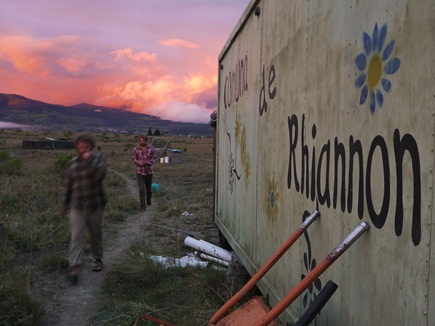
5.30pm. As the sun begins to drop, the last job of the day is to bring the donkeys in. Most days, the clouds have rolled in by now, bathing the farm in mist – but just occasionally it remains clear…
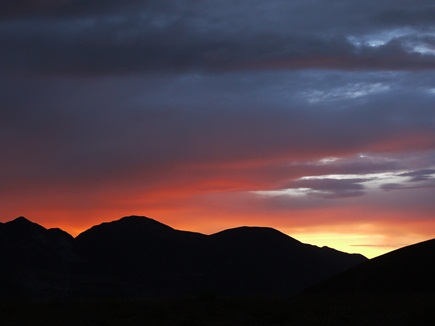
…and the sunset over the mountains is a stunner.
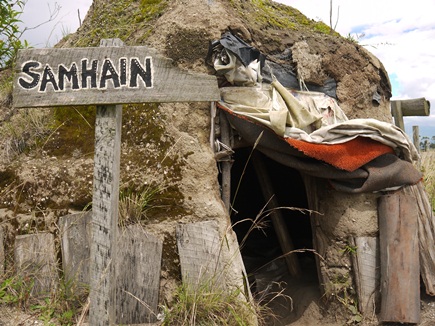
Occasionally there are organised evening activites, like the temascal ceremony which was one of my favourite experiences at Rhiannon. Imagine the most intense steam room ever, but inside a tiny adobe hut in the pitch black, shoulder to shoulder with twelve other people. Then bring in red hot stones which have been heated in an enormous fire, and add water. As the ceremony progresses more stones are brought in and the temperature rises, accompanied by singing and prayers. The aim is that the profuse sweating and meditation acts as a purge – and for me, emerging from the hut into the cool night after two hours was literally like being born again. Thank you Monika for leading an amazing experience.
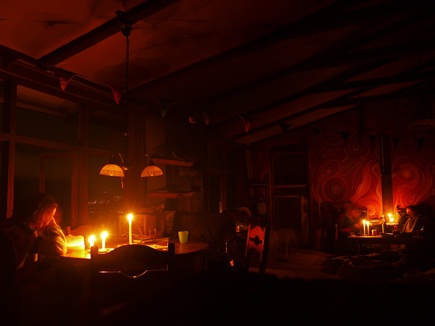
8pm. Otherwise, evenings at Rhiannon are usually a relaxed affair around the woodburner: reading, talking, attempting to make bread or desert in the fire (requires a degree in flame control), or playing board games – Jaco and Stefan's “Beanopoly”, a home-made South African version of Monopoly using beans for currency was a triumph.
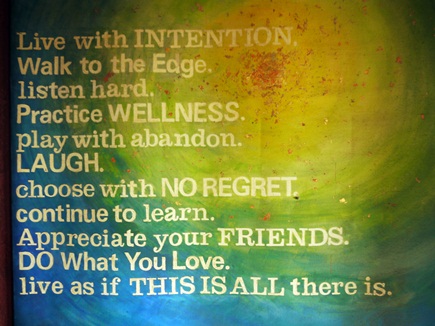
The Rhiannon philosophy – Do what you love. I'm not sure I could think of a better set of principles to live by. A massive thank you to Helen, Nicky, Satya and all the other volunteers for a wonderful month of work and laughter with the Rhiannon family. We'll miss you all!
Decisions, decisions: exiting Ecuador
May 28th, 2013
In our last few weeks in Ecuador, it seemed everyone was obsessed with telling us how much of their country we had missed. Geographically, Ecuador is split into three parts: the coast on the west, the jungle to the east and in the centre, the Andes – which form the spine of the country from north to south. Reluctant to make a long descent to either coast or jungle and then have to make a big climb up again to the cordillera, we stuck doggedly to the mountains.
The head shakes and sighs we encountered when people learned of our neglect of the coast and jungle led us to start asking questions about the route decisions we make. When travelling by bike, you are inevitably forced to choose your route through just one small section of a country, unless you have endless time to divert and wander. Every time you choose one path, another is closed to you (until next time at least) and there’s always a sense that you may have missed something. Had we made a mistake and chosen the wrong path through Ecuador?
After the umpteenth conversation about how silly we were to neglect Ecuador’s “best” sites, we reconciled that it wasn’t about a terrible choice we had made and what we were missing – it was more about learning to accept what we like doing. For the views, the climate, the people and the roads, staying up in the Andes holds the most appeal. This trip has turned us into montañeros – mountain people. Cycling through the mountains might be difficult, but to us it’s far preferable to the humidity of the enclosed jungle and its hungry bugs or the flatlands and scorching dry heat of the coast.
Decision making has become harder and harder as the realisation dawns on us how much South America has to offer. This is magnified by the fact that when travelling as a couple every choice is a compromise, a discussion, often over-analysed and always subject to the second-guessing of your partner. Everything is up for debate: which road to take, where to drink a coffee, what time to set the morning alarm, when to stop for lunch, where to stock up on supplies, whether to cook fried eggs or scrambled for breakfast on a rest day, and even which brand of toilet roll to buy. Thankfully the only thing we really bang heads over is how to eat our eggs.
When it came to deciding whether to cross the border from Ecuador to Peru via the coast or the mountains though, there was no deliberation from either of us: mountains all the way. So with everyone’s advice ringing in our ears, we ignored it and took to the hills south of Cuenca to cross into Peru.
Sarah
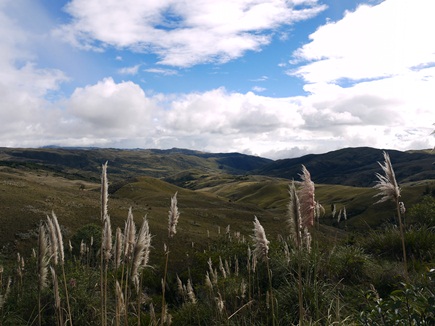
The ride out of town spits us out into the countryside fairly swiftly and after nearly six weeks off the bikes, the legs start to feel the burn immediately.
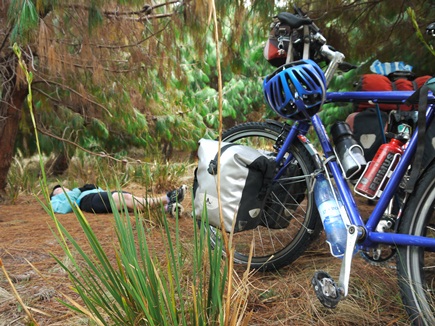
First night’s accommodation turns out to be a cosy little spot nestled among some pine trees at over 3000m…
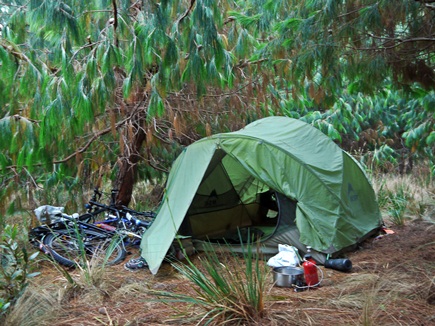
…and as we remind ourselves how to put up the tent on a nice spongy bed of pine needles, the stove bubbles away with a quinoa/pasta feast.
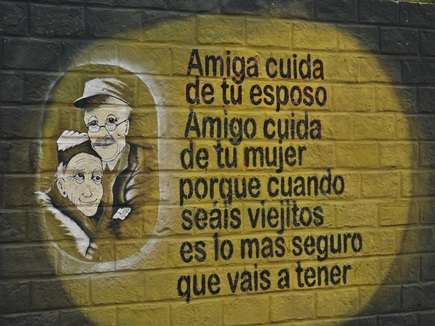
It’s appropriate that we arrive in Vilcabamba – Ecuador’s village of eternal youth – on the day before my birthday. The poem reads “Lady take care of your husband, man take care of your woman, because when you are both elderly, the only sure thing you will have is each other”.
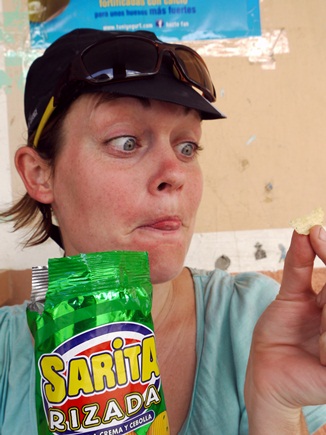
…even happier when I find a packet of crisps bearing my adopted Spanish name; what a treat – doesn’t take much to please this birthday girl.
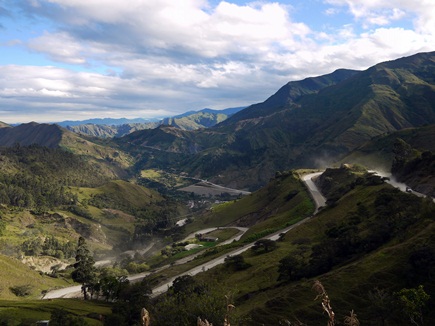
Then after the crisp excitement, it’s back to business as usual the next day with a long but beautiful climb on the way to Valladolid.
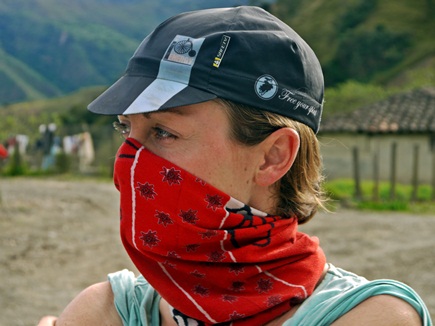
We are warned of major roadworks ahead with accompanying mud and dust so the buff comes out for the chic cyclist/bandit look.
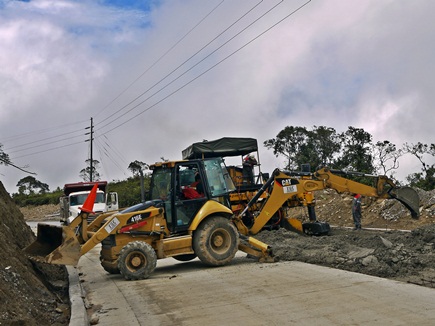
…and ongoing construction provides a chance to stop for a breather and chat to the friendly gangs of engineers who line this part of the route.
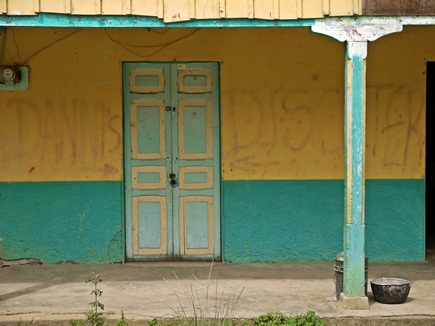
In Valladolid on a Saturday night, on the weekend of my birthday, we are sorely tempted to stick around and see what goes down at Danni’s Discotek…
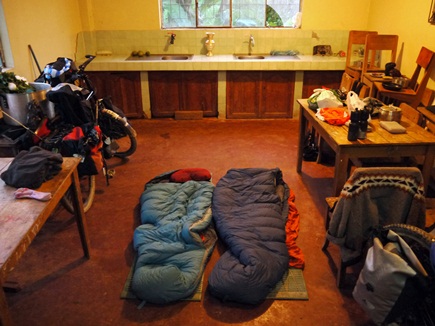
…instead we end the day further along the road at Palanda, camped out in the church sacristy while ladies busily prepare the next day’s flower arrangements around us.
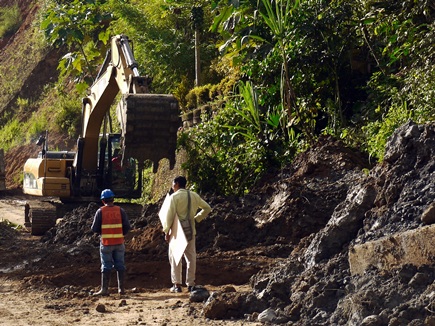
Onto dirt after Palanda, and though the road building continues we are lucky to get away with very little mud – cyclists passing through here shortly before us talked of pushing their way through ankle deep bogs.
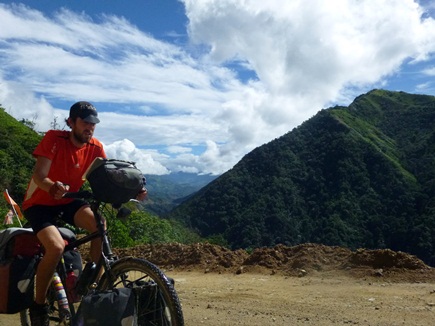
A nasty steep climb in the rising heat has us both seeing stars by the time we reach Progreso for lunch.
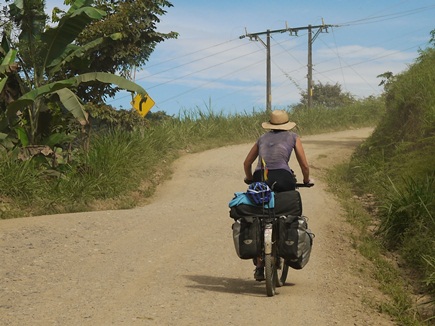
There’s only more of the same after lunch; it feels like we are back in Central America and with sweat pouring off in all directions, we dig out the sun hats, slap on the factor 100 and grind into the pedals. This is by far the hottest weather we have experienced in Ecuador and it feels alien. Making it to Zumba feels like a real achievement.
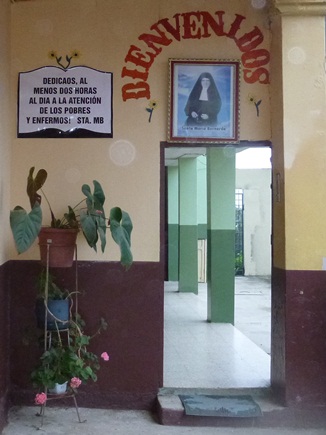
Our last night in Ecuador mirrors our last night in Colombia – spent enjoying the hospitality of the local nuns; we camp in the cloisters of the convent at Zumba…
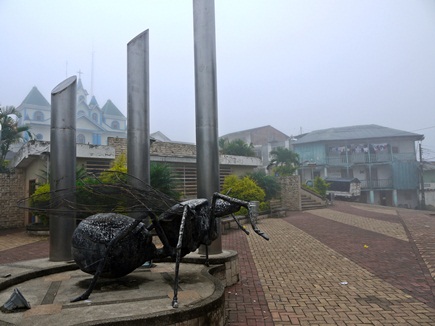
…and in the early morning mist, we leave the oddly placed mosquito sculpture behind us in the town square and set off for the border.
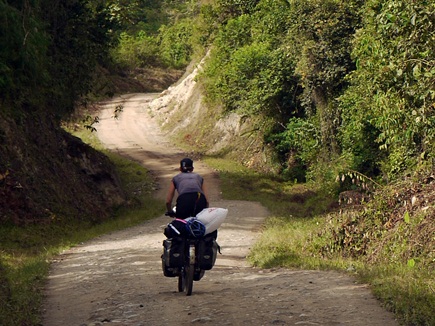
This road through the mountains into Peru is a pretty quiet crossing and the dirt track leading to immigration at La Balsa hardly feels like we’re on the way to an international border.

